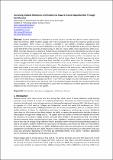| dc.contributor.author | McGuire, Adam | |
| dc.contributor.author | O Brion, Daire | |
| dc.contributor.author | White, P.J. | |
| dc.contributor.author | Deevy, Colin | |
| dc.contributor.author | Power, Ken | |
| dc.date.accessioned | 2023-05-08T10:13:59Z | |
| dc.date.available | 2023-05-08T10:13:59Z | |
| dc.date.copyright | 2017 | |
| dc.date.issued | 2017-10 | |
| dc.identifier.citation | Mcguire, A., O’Broin, D., White, P.J., Deevy, C. & Power, K. (2017). Increasing Student Motivation and Awareness of Career Opportunities Through Gamification. Paper presented at the European Conference on Games Based Learning, Austria. | en_US |
| dc.identifier.uri | https://research.thea.ie/handle/20.500.12065/4505 | |
| dc.description.abstract | Student engagement is important to ensure success towards their desired career opportunities (High and Andrews, 2009). Students engage with their coursework to receive the necessary grades to avoid failure (Covington, 1999). Failure can indicate a disbelief in their abilities, therefore engagement with assignments becomes a zero sum game (Middleton and Perks 2014). The results from a 2012 survey in America stated that 87.9% of the students attended college in order to receive better career opportunities (Astin et al., 2012). Intercept interviews consisting of 8 students also indicated that career opportunities are the end goal and main motivator for engagement with course modules but the relevance of some modules can be unclear to the student which decreases engagement levels with that subject. Because of this, the student may not develop the particular skillsets necessary to achieve their desired career choice. A limited awareness of career choices and what skills they require have been identified as problem areas from the interviews. To help students engage with their studies and achieve their desired career choice, students require constant feedback that is relevant to each of their identity-related needs. The development of a system that focuses on these needs may provide a clear path outlining what skillsets are necessary for each career choice and how to build them. This study utilizes gamification, the use of game elements in a non-game context, to address student needs and to answer the following research question: To what degree can a gamification system help increase student engagement and what effect do particular elements have on the user's engagement? The approach used for this study was human-centred design to develop a gamified system that focuses on the needs of the student while delivering an engaging experience. A low-fidelity prototype has been developed which focuses on developing skillsets relevant to real world jobs. The prototype has gone through user testing using the think aloud protocol. The users were interviewed to allow them to reflect back on their experience and provide feedback for the next iteration of the system. | en_US |
| dc.format | application/pdf | en_US |
| dc.language.iso | eng | en_US |
| dc.relation.ispartof | the European Conference on Games Based Learning | en_US |
| dc.rights | Attribution 3.0 United States | * |
| dc.rights.uri | http://creativecommons.org/licenses/by/3.0/us/ | * |
| dc.subject | gamification | en_US |
| dc.subject | awareness | en_US |
| dc.subject | engagement | en_US |
| dc.subject | motovation | en_US |
| dc.subject | careers | en_US |
| dc.title | Increasing student motivation and awareness towards career opportunities through gamification | en_US |
| dc.type | info:eu-repo/semantics/article | en_US |
| dc.conference.date | 2017-10 | |
| dc.conference.location | Graz, Austria | en_US |
| dc.contributor.affiliation | DesignCORE, Humanities, South East Technological University, Kilkenny Road, Carlow, Ireland | en_US |
| dc.description.peerreview | yes | en_US |
| dc.identifier.orcid | https://orcid.org/0000-0002-5716-8643 | en_US |
| dc.identifier.url | https://www.researchgate.net/publication/335455939_Increasing_Student_Motivation_and_Awareness_Towards_Career_Opportunities_Through_Gamification | en_US |
| dc.rights.accessrights | info:eu-repo/semantics/openAccess | en_US |
| dc.subject.department | designCORE - SETU Carlow | en_US |
| dc.type.version | info:eu-repo/semantics/acceptedVersion | en_US |


